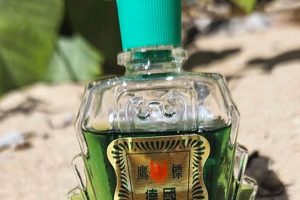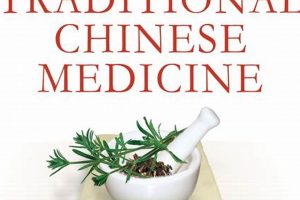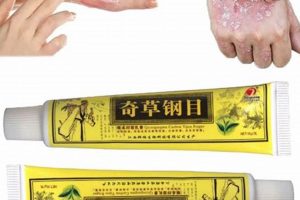The practice of revitalizing traditional Chinese medicine through herbal remedies constitutes a significant area within complementary and alternative medicine. This involves employing various plant-derived substances to restore vitality, alleviate ailments, and promote overall well-being. An example is the use of ginseng to combat fatigue and enhance cognitive function.
The significance of this approach lies in its potential to offer natural alternatives for managing health conditions, drawing upon centuries of accumulated knowledge and experience. Historically, these remedies have played a crucial role in healthcare across East Asia, emphasizing a holistic view of health that considers the interconnectedness of body, mind, and spirit. Benefits are often touted in terms of improved energy levels, enhanced immune function, and better management of chronic diseases.
The following sections will delve into specific applications, key ingredients, and considerations regarding the safe and effective utilization of plant-based therapies rooted in traditional Chinese practices. Subsequent analysis will also address the regulatory landscape and ongoing research efforts in this domain.
Guidance on Herbal Revitalization
The following recommendations offer insights into the responsible and informed consideration of plant-based treatments for health restoration. Adherence to these points promotes a more secure and beneficial experience.
Tip 1: Consultation with Qualified Practitioners: Prioritize seeking advice from certified practitioners of Traditional Chinese Medicine (TCM). These professionals possess the expertise to accurately diagnose conditions and prescribe appropriate herbal formulations.
Tip 2: Sourcing from Reputable Suppliers: Ensure that herbal products are obtained from trusted vendors who adhere to stringent quality control standards. This minimizes the risk of contamination or adulteration.
Tip 3: Understanding Individual Herbal Properties: Research the specific actions and potential side effects of each herb within a given formula. This facilitates informed decision-making and proactive management of any adverse reactions.
Tip 4: Gradual and Measured Implementation: Introduce herbal remedies into one’s regimen gradually, starting with lower doses and carefully monitoring for any changes or sensitivities. This allows for better assessment of individual tolerance.
Tip 5: Awareness of Potential Interactions: Be cognizant of potential interactions between herbal remedies and conventional medications. Disclose all current medications to the TCM practitioner to avoid contraindications.
Tip 6: Importance of Lifestyle Integration: Recognize that herbal revitalization is most effective when integrated with a holistic approach that encompasses proper nutrition, adequate rest, and stress management techniques.
Tip 7: Consistent Monitoring and Evaluation: Regularly assess the effectiveness of the herbal treatment plan and communicate any concerns or lack of improvement to the prescribing practitioner.
Consistent application of these guidelines enhances the likelihood of achieving desired health outcomes while minimizing potential risks. A cautious and informed approach is paramount.
The subsequent sections will explore the regulatory framework governing these herbal therapies and delve into ongoing scientific investigations aimed at validating their efficacy and safety.
1. Herbal Sourcing Authenticity
Herbal sourcing authenticity forms a cornerstone of the effective application of plant-based remedies derived from traditional Chinese medicine. The connection is causal: the authenticity of the herbal ingredients directly impacts the efficacy and safety of the resulting treatment. If an herb is misidentified, adulterated, or improperly processed, its therapeutic properties may be diminished or even altered, potentially leading to adverse health outcomes rather than the intended revitalization. Real-life examples include cases where toxic plants have been mistakenly substituted for medicinal herbs, resulting in serious illness or death.
The importance of authentic sourcing extends beyond simply identifying the correct plant species. It also encompasses factors such as the growing conditions, harvesting methods, and post-harvest processing techniques employed. Each of these elements can influence the chemical composition and thus the therapeutic potential of the herb. For example, ginseng grown in different regions or harvested at different times may exhibit variations in its ginsenoside content, which is believed to be responsible for many of its health benefits. Ensuring authentic sourcing requires rigorous quality control measures throughout the supply chain, from the field to the dispensary.
In summary, herbal sourcing authenticity is not merely a desirable attribute but a fundamental prerequisite for realizing the potential benefits of traditional Chinese herbal medicine. Challenges remain in establishing and maintaining robust quality control systems, particularly given the complex global supply chains involved. A continued emphasis on verification and traceability is essential to safeguarding patient health and upholding the integrity of the practice.
2. Practitioner Qualifications
Practitioner qualifications represent a crucial determinant in the safe and effective application of herbal remedies rooted in traditional Chinese medicine. The level of training, expertise, and ethical conduct of the practitioner directly impacts the quality of care and the potential for successful revitalization of health.
- Diagnostic Accuracy
A qualified practitioner possesses the skills necessary to accurately diagnose imbalances according to TCM principles. This involves assessing the patient’s constitution, symptoms, and lifestyle factors to identify the underlying causes of their condition. Inaccurate diagnoses can lead to the prescription of inappropriate herbal formulas, potentially exacerbating the patient’s health issues. For instance, misdiagnosing a “cold” pattern as a “hot” pattern could result in the administration of herbs that worsen the condition.
- Herbal Formulation Expertise
The formulation of herbal prescriptions requires a deep understanding of the properties and interactions of individual herbs. Qualified practitioners are trained to select and combine herbs in a way that addresses the patient’s specific needs while minimizing the risk of adverse effects. They also understand how to modify formulas based on the patient’s response to treatment. For example, a practitioner must know which herbs to avoid in patients with specific allergies or medical conditions.
- Safety and Monitoring Protocols
Qualified practitioners are knowledgeable about the potential side effects and contraindications of herbal remedies. They establish protocols for monitoring patients for adverse reactions and are prepared to adjust or discontinue treatment as necessary. They also counsel patients on potential interactions between herbal formulas and conventional medications. A practitioner trained in safety protocols can prevent potentially life-threatening situations.
- Ethical Conduct and Scope of Practice
Ethical practitioners adhere to a code of conduct that prioritizes patient safety and well-being. They practice within the scope of their training and expertise and refer patients to other healthcare professionals when necessary. They also provide patients with clear and accurate information about the benefits and risks of herbal treatment. For example, a practitioner must be transparent about the limitations of herbal medicine and avoid making unsubstantiated claims.
In conclusion, the qualifications of the practitioner play a pivotal role in determining the success or failure of herbal treatment for health restoration. Patients should seek out practitioners who have completed accredited training programs, hold relevant certifications, and demonstrate a commitment to ethical practice. The revival of traditional Chinese herbal medicine hinges on the competence and integrity of its practitioners.
3. Formulation Customization
Formulation customization constitutes a central tenet in the application of herbal remedies within the framework of revitalizing traditional Chinese medicine. This individualized approach acknowledges the inherent variability among individuals and their unique health conditions, moving beyond a one-size-fits-all paradigm.
- Individual Constitution Assessment
The process commences with a thorough assessment of the patient’s constitution, taking into account factors such as age, gender, body type, and temperament. This assessment informs the selection of herbs that are specifically suited to address the individual’s underlying imbalances. For instance, a patient with a “Yin deficient” constitution may require herbs that nourish Yin and clear heat, whereas a patient with a “Yang deficient” constitution may benefit from warming and tonifying herbs. Failure to consider individual constitution can lead to ineffective or even harmful treatment outcomes.
- Symptom Specificity
Formulas are meticulously tailored to address the patient’s specific symptoms, taking into account the nature, location, and duration of each symptom. This may involve combining herbs with different actions to target multiple symptoms simultaneously. For example, a patient experiencing both pain and inflammation may receive a formula that includes herbs with analgesic and anti-inflammatory properties. A cookie-cutter approach often ignores the nuance of symptoms.
- Dynamic Adaptation
Formulation customization is not a static process but rather a dynamic adaptation that evolves over time as the patient’s condition changes. Practitioners regularly monitor the patient’s response to treatment and adjust the formula accordingly, based on their observations and the patient’s feedback. This iterative approach ensures that the treatment remains aligned with the patient’s evolving needs. Such dynamic adjustments is a contrast to fixed treatments
- Herbal Interactions and Synergy
Customization also considers the complex interactions among different herbs within a formula. Practitioners carefully select herbs that work synergistically to enhance the overall therapeutic effect while minimizing the risk of adverse reactions. A well-designed formula can achieve a greater therapeutic effect than the sum of its individual parts. The balance between efficacy and safety is a focus on such consideration.
The aforementioned facets of formulation customization underscore its integral role in the revitalization of Chinese herbal medicine. It ensures that treatment is not only targeted and effective but also safe and individualized, aligning with the holistic principles of TCM. In contrast to standardized pharmaceutical approaches, this tailored method aims to harmonize the individual’s unique physiology, facilitating a more profound and lasting restoration of health and vitality. Such formulation could potentially impact patients life in a positive way.
4. Safety Monitoring
Safety monitoring forms an indispensable component of any endeavor to revive traditional Chinese herbal medicine. The direct correlation between diligent monitoring and patient well-being is undeniable. The utilization of herbal remedies, while often perceived as natural and therefore benign, carries inherent risks that necessitate careful observation and intervention. Adverse reactions, herb-drug interactions, and the potential for contamination or misidentification of herbs all underscore the critical importance of vigilant safety protocols. A real-life example includes cases of liver damage associated with the use of certain herbal products, highlighting the potential for serious harm if safety measures are neglected. Therefore, safety monitoring plays a vital role to revive chinese herbal.
Effective safety monitoring encompasses several key aspects. It begins with a thorough patient history and physical examination to identify any pre-existing conditions or sensitivities that may increase the risk of adverse events. During treatment, patients should be regularly assessed for signs and symptoms of adverse reactions, and laboratory tests may be necessary to monitor organ function. Furthermore, it requires robust quality control measures throughout the herbal supply chain, from cultivation and harvesting to processing and distribution. Accurate identification of herbal species is paramount, and measures must be taken to prevent contamination with toxins or heavy metals. In clinical settings, practitioners must be trained to recognize and manage adverse reactions, as well as to counsel patients on potential risks and benefits of herbal therapy. Such measurement will significantly enhance the revive chinese herbal treatment.
In summary, safety monitoring is not merely an adjunct to the revitalization of Chinese herbal medicine but rather an essential pillar upon which its responsible and effective application rests. Challenges persist in establishing and enforcing rigorous safety standards, particularly in the context of globalized herbal markets. Continued investment in research, education, and regulatory oversight is critical to ensuring the safety of patients who seek to benefit from these traditional remedies. Increased safety can potentially enhance the revive chinese herbal effectiveness in the future.
5. Integration with Lifestyle
The integration of lifestyle modifications constitutes an integral, often overlooked, component of any successful strategy to revitalize health via traditional Chinese herbal medicine. The administration of herbal remedies in isolation, without addressing underlying lifestyle factors, frequently yields suboptimal outcomes. This is because many health imbalances stem directly from lifestyle choices, such as dietary habits, physical activity levels, stress management techniques, and sleep hygiene. Therefore, the therapeutic potential of plant-based medicines is maximized when coupled with conscious lifestyle adjustments.
Consider, for example, an individual seeking herbal treatment for chronic fatigue. While a TCM practitioner might prescribe herbs to tonify Qi and strengthen the Spleen, the patient’s condition is unlikely to improve significantly if they continue to consume a diet high in processed foods, engage in sedentary behavior, and experience chronic sleep deprivation. In such a case, the herbs may provide temporary relief, but the underlying causes of the fatigue remain unaddressed. Similarly, an individual using herbal remedies to manage anxiety may find limited relief if they fail to incorporate stress-reduction techniques, such as meditation or deep breathing exercises, into their daily routine. Real-life examples abound, demonstrating the synergistic effect of combining herbal therapy with targeted lifestyle modifications. Patients who adopt a healthy diet, engage in regular exercise, and prioritize stress management often experience more significant and lasting improvements in their health compared to those who rely solely on herbal remedies. This holistic approach is fundamental to the principles of TCM, which emphasizes the interconnectedness of body, mind, and spirit.
In conclusion, the integration of lifestyle changes is not merely a complementary aspect of herbal treatment but rather an essential prerequisite for achieving optimal health revitalization. Practitioners of TCM must emphasize the importance of lifestyle modifications and work collaboratively with patients to develop personalized strategies that address their specific needs and circumstances. By embracing a holistic approach that encompasses both herbal therapy and lifestyle changes, individuals can unlock the full potential of traditional Chinese medicine and achieve a more profound and sustainable level of well-being. Overlooking the lifestyle factor is akin to treating the symptoms while ignoring the root cause.
Frequently Asked Questions
The following addresses common inquiries regarding the principles and practice of revitalizing health through traditional Chinese herbal medicine. It aims to provide clear and concise information based on established knowledge and best practices.
Question 1: Is “revive Chinese herbal” a universally applicable solution for all ailments?
No. While traditional Chinese herbal medicine offers potential benefits for a wide range of conditions, it is not a panacea. Its effectiveness varies depending on the individual’s constitution, the nature and severity of the condition, and other factors. Consultation with a qualified practitioner is essential to determine suitability.
Question 2: Are there potential risks associated with efforts to “revive Chinese herbal”?
Yes. As with any form of medical treatment, the utilization of herbal remedies carries potential risks, including adverse reactions, herb-drug interactions, and contamination with toxins or heavy metals. Proper sourcing of herbs, qualified practitioners, and diligent safety monitoring are crucial to mitigating these risks.
Question 3: How does “revive Chinese herbal” differ from conventional Western medicine?
Traditional Chinese herbal medicine typically adopts a more holistic approach, focusing on restoring balance and harmony within the body rather than simply suppressing symptoms. It also emphasizes individualized treatment plans tailored to the patient’s unique constitution and condition. Conventional Western medicine often employs more standardized treatment protocols.
Question 4: What qualifications should one seek in a practitioner of “revive Chinese herbal”?
Individuals seeking herbal treatment should seek out practitioners who have completed accredited training programs in Traditional Chinese Medicine, hold relevant certifications, and demonstrate a commitment to ethical practice. Verification of credentials is advisable.
Question 5: Can “revive Chinese herbal” be safely combined with conventional medications?
The potential for interactions between herbal remedies and conventional medications exists. Transparency and open communication with both the TCM practitioner and the medical doctor are essential to avoid adverse effects. Consultation with a pharmacist is also recommended.
Question 6: How long does it typically take to see results from “revive Chinese herbal” treatment?
The timeframe for experiencing noticeable results varies depending on the individual and the condition being treated. Some individuals may experience improvement within a few weeks, while others may require several months of consistent treatment. Patience and adherence to the prescribed regimen are important.
In summary, the safe and effective utilization of plant-based remedies for health revitalization requires a cautious, informed, and individualized approach. The guidance of a qualified practitioner and adherence to safety protocols are paramount.
The next section will delve into resources and further reading materials for those interested in pursuing a deeper understanding of traditional Chinese herbal medicine.
Conclusion
This exposition has traversed the landscape of “revive chinese herbal,” underscoring the critical interplay of authentic sourcing, qualified practitioners, customized formulations, rigorous safety monitoring, and integrated lifestyle adjustments. The revitalization of traditional health practices demands a multifaceted approach, acknowledging both the potential therapeutic benefits and the inherent responsibilities associated with herbal medicine.
The future of “revive chinese herbal” lies in fostering a deeper understanding of its principles, promoting ethical and evidence-based practices, and ensuring accessible, safe, and effective care for those seeking its benefits. Further research, education, and regulatory oversight are essential to realizing the full potential of this ancient healing tradition. The onus remains on practitioners, researchers, and policymakers to uphold the integrity and safeguard the public health within this evolving domain.







